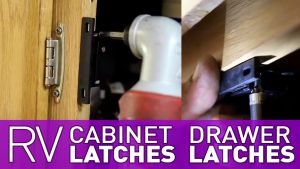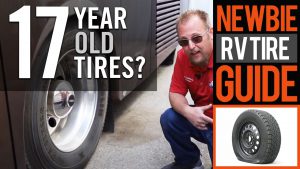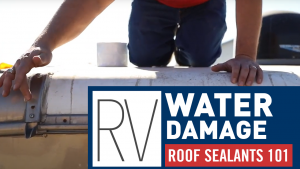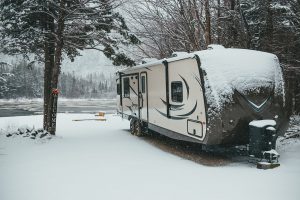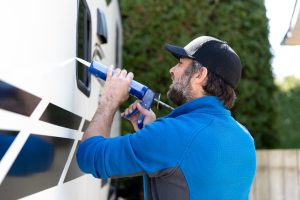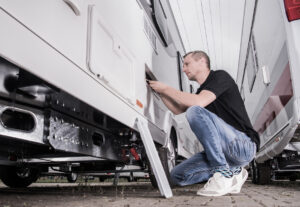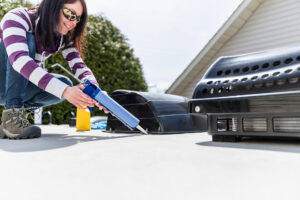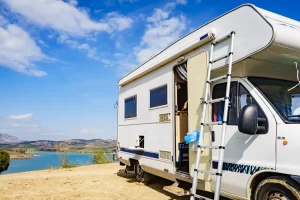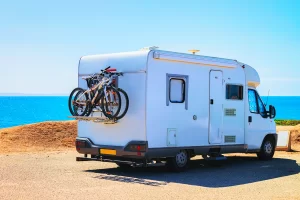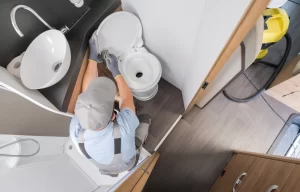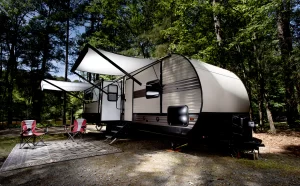From emergency repairs to everyday maintenance, every RV owner will encounter situations where they need a fully stocked tool kit. What should you absolutely include in yours?
If something is leaking or isn’t working properly, the tools listed below will help you diagnose and fix the issue as quickly as possible.
1. Toolbox/Kit
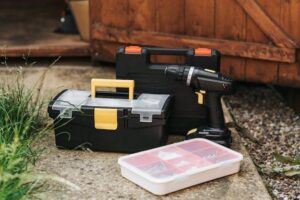
First, and perhaps most importantly, is a standard toolbox or kit that includes some essential tools, including the following:
- Screwdriver: Since space is limited in an RV, look for a screwdriver with interchangeable tips. That way, you’ll always have the size you need without carrying around multiple screwdrivers.
- Hammer: A 16-ounce claw hammer will work well for most tasks.
- Tape Measure: A tape measure will come in handy when you need to measure spaces to ensure new equipment or devices will fit into your RV.
- Utility Knife with Extra Blades: Choose a basic utility knife model with a retracting blade and nonslip handle. Get plenty of spare blades, too.
- Adjustable Wrenches: An adjustable wrench can help you save space while still making sure you have the appropriate tool for various projects.
- Safety Glasses: Keep glasses on hand to protect your eyes from flying dirt and debris.
- Power Drill: A cordless power drill can speed up time-consuming projects and help you work more efficiently.
These crucial items will be sufficient to get you through many everyday repairs and maintenance tasks. Even if you’re working with a tight budget, start with these supplies and then work your way up by gradually adding the others listed below.
2. Ratchet Set

A ratchet set, also known as a socket wrench set, typically includes a ratcheting handle and a variety of interchangeable sockets. The ratcheting handle can turn in one direction while holding its position in the opposite direction, making it easier to use in confined spaces (like your RV).
3. Duct Tape
It’s always a good idea to keep at least one roll of duct tape on hand. You can use it as a temporary tool to hold parts together, seal cracks and leaks, etc.
4. Plumber’s Tape
Plumber’s tape is made from polytetrafluoroethylene (PTFE), which is also used in nonstick cookware, eyeglasses, and razor blades. PTFE is also nonflammable and nontoxic.
Plumber’s tape will come in very handy for various plumbing projects. It’s strong enough that you can use it as a temporary sealant, but it’s less sticky than duct tape.
5. Assorted Zip Ties
You can use zip ties for a variety of tasks, from unclogging a drain to securing cabinetry to holding bundles of wires together. You can even use them as makeshift clamps to hold items together while you work on a more permanent solution.
Keep zip ties on hand in a range of widths and lengths so you can always find the size you need.
6. Electrical Tape
Electrical tape has excellent moisture-, abrasion- and corrosion-resistant properties. You can use it to insulate electrical wires, make minor repairs to damaged wires, secure wire bundles, and more.
7. Electrical Pliers
Keep a range of electrical pliers on hand for cutting, crimping, etc. Here are some of the most useful plier types to keep in your toolbox for everyday repairs and maintenance:

- Needle-Nose Pliers: These pliers feature long, narrow jaws with pointed tips, useful for reaching into tight spaces. They’re ideal for gripping, bending, and manipulating small wires or components.
- Diagonal Cutting Pliers: Also referred to as wire cutters or side-cutting pliers, they are designed for cutting wires, especially in confined spaces. The cutting edges are at an angle to the handles, allowing for close cuts.
- Lineman’s Pliers: Also called combination pliers or side-cutting pliers, they have a heavier and sturdier construction compared to needle-nose pliers. They’re suitable for gripping, bending, twisting, and cutting electrical wires.
- Wire Stripping Pliers: These pliers are designed to remove insulation from wires. They feature a notch or cutting edge for stripping the outer insulation without damaging the inner conductor.
- Crimping Pliers: These pliers are used for crimping connectors onto the ends of wires. They’re often used in conjunction with terminal connectors or splices.
- Flat-Nose Pliers: These pliers have flat, wide jaws with a broader surface area. They’re useful for gripping, bending, and holding flat objects or wires.
- Round-Nose Pliers: These pliers feature round, tapered jaws. They’re ideal for forming loops or bends in wires, making them suitable for tasks like creating wire connections.
- Cable Cutters: As the name suggests, these pliers are designed for cutting larger cables and wires. They have strong cutting blades capable of handling thick cables.
- Locking Pliers: These pliers have an adjustable jaw that can be locked into position, providing a secure grip. They help hold or clamp objects in place while working.
8. Spare Fuses
Fuses protect wires from an overcurrent event, such as an electrical short. The following are some examples of spare fuses you’ll want to keep in your RV tool kit:
- Blade Fuses (ATC/ATO): These are the most common type of automotive fuses and are often found in RVs. They have a flat, rectangular shape with two parallel metal blades, are available in various amperage ratings, and are color-coded for easy identification.
- Mini Blade Fuses (ATM): These are similar to blade fuses but smaller in size. They’re used in situations where space is limited and are also available in various amperage ratings and color-coded.
- Micro Blade Fuses: These are even smaller than mini blade fuses. They’re used in compact electronics and tight spaces.
- Glass Tube Fuses: These consist of a glass tube with metal end caps. They’re commonly found in older RVs and are available in different lengths and amperage ratings.
- ANL Fuses: These are larger fuses that are typically used in high-current applications. They have a flat, wide shape with bolt-on terminals and are commonly used in RVs for heavy-duty electrical systems.
- Resettable Thermal Circuit Breakers: These are automatically reset when the circuit cools down after tripping. They are suitable for protecting various circuits in an RV.
- DC Voltage Fuses: These are specifically designed for direct current (DC) applications, which are common in RVs. They have ratings suitable for the DC voltage systems in RVs.
9. Multimeter
A multimeter, short for “multiple meter,” is a tool used for measuring various electrical properties in a circuit, including these:
- Voltage (Volts): Measures the potential difference between two points in a circuit, indicating the electrical force pushing the flow of current.
- Current (Amperes or Amps): Measures the flow of electric charge through a conductor. Multimeters are usually connected in series to measure current.
- Resistance (Ohms): Measures the opposition a material or component offers to the flow of electric current.
- Continuity: Checks if a circuit is continuous or if there is a break in the path. It is useful for identifying open circuits or faulty connections.
- Diode Testing: Determines if a diode is functioning correctly by checking its forward voltage drop.
- Capacitance: Measures the capacitance of a capacitor, indicating its ability to store electrical charge.
- Frequency: Measures the frequency of an alternating current (AC) signal.
- Temperature: Some advanced multimeters come with a temperature measurement function using a thermocouple or a temperature probe.
10. Alligator Cables
In addition to a multimeter, it’s a good idea to have some alligator cables or clips on hand. Alligator clips have long, serrated jaws and can be used to establish temporary electrical connections when they’re clipped to terminals and components. They allow you to extend the reach of your multimeter.
11. Spare Electrical Wire
It’s always a good idea to have extra electrical wire on hand.
There are two primary types of wires you can choose from: stranded and solid. Stranded wires consist of metal strands, whereas solid wires use just one solid piece of metal.
Stranded wires are flexible, easy to work with, and can handle vibration. They’re also resistant to corrosion. The downside is that they’re typically more expensive than solid wires.
With this information in mind, most RV experts recommend copper-stranded wire because it manages vibrations better and is resistant to high temperatures, making it safer than some other wire types.
12. Flashlight or Headlamp
Repairs can’t always wait for the morning. Sometimes, you need to get started on a repair in the middle of the night. In these cases, a flashlight or headlamp will come in handy.
You can also use a flashlight or headlamp when working in tight, dark spaces.
13. Rags
Keep a collection of old rags in your tool kit, too. That way, if a leak happens, you don’t have to use your nice towels to sop up the water (or any other liquids).
14. Roof Repair Tape
Roof repair tape is helpful for emergency leaks in skylights and roof vents. Roof repair tape is made of three primary materials:
- Modified Bitumen: Modified Bitumen is the most common type of roof repair tape. It is made from petroleum and asphalt. It is popular because it is the least expensive option, but it will also dry out over time, which interferes with its effectiveness.
- Butyl: Butyl adhesive technology is another popular option, but it’s important to check the temperature range when choosing a roll. Some are modified to be more effective in cold weather, so if you’re camping in a chilly place, you’ll want to make sure you select that variety.
- Acrylic: Acrylic is the strongest option for roofing tape because it has a long lifespan and is effective in a wide range of temperatures. It’s also the most expensive option.
15. Roof Sealant and Caulking Gun
Roof sealant is an adhesive coating that can create a protective barrier over the roof of your RV. It seals cracks, gaps, and damaged areas to protect you and your travel companions (as well as your RV’s interior) from the elements.
Keeping roof sealant and a caulking gun on hand ensures you can seal cracks and stop leaks quickly. It can also provide better insulation and prevent leaks from happening in the first place.
16. Straps
Straps are useful for holding awning arms in place while traveling. You never know when your straps might get worn out, so it’s a good idea to keep some extra ones in your toolbox. That way, when you need them, you’ll know exactly where to look!
17. Wood Glue and Toothpicks
A loose cabinet might not be as serious as a roof leak or an electrical issue, but it can still be frustrating, especially when you’re going on a long RV trip. If you notice a loose cabinet, you can use a little wood glue and some toothpicks to fix it.
18. Drawer Latches
Drawer latches will keep your drawers closed and save your belongings from spilling all over the RV while you’re traveling. They’re also inexpensive and easy to install, so why wouldn’t you want to keep them in your toolbox?
19. Spare Water Pump Parts
A functioning water pump is crucial to a successful RV trip. To save yourself from making an emergency trip to the hardware store, make sure you have spare water pump parts in your tool kit.
The following are some of the most essential parts to store in your toolbox:
- Impeller: The rotating component that generates the necessary pressure to move water.
- Housing: Encases the motor and impeller to contain and direct the water flow.
- Inlet and Outlet Ports: The inlet is connected to the freshwater tank, while the outlet connects to the RV’s plumbing system.
- Pressure Switch: Monitors the water pressure in the system.
- Check Valve: Prevent water backflow.
- Strainer/Filter: Prevents debris and particles from entering the pump.
- Mounting Base: Provides stability and support
- Pressure Regulator: Controls and adjusts the water pressure coming out of the pump
Need Help with Repairs? We’ve Got the RV Tools
A well-stocked tool kit will go a long way when it comes to managing RV repairs and maintenance. However, sometimes, you need extra support to keep your RV running smoothly.
If you run into a problem you can’t manage on your own, don’t panic. Our team at Leisure Coachworks is here to help.
Reach out today to learn more about our repair and maintenance services.

